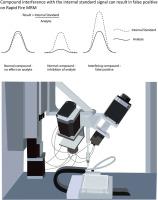克服RapidFire核磁共振高通量筛选中的假阳性机制。
IF 2.7
4区 生物学
Q2 BIOCHEMICAL RESEARCH METHODS
引用次数: 0
摘要
假阳性通常困扰高通量筛选,并且由于它们消耗资源和时间来解决,因此成本很高。因此,能够在初始筛选时快速识别这些化合物的方法具有很大的价值。质谱法的进步使我们能够通过直接检测酶反应产物来筛选药物发现应用中的抑制剂。该技术不受荧光干扰等传统分析方法的干扰。它的直接性质否定了偶联酶的需要,因此更简单,人工制品的机会更少。尽管有无数的优点,我们在这里报告了一种在文献中没有报道过的假阳性命中的机制。此外,我们还开发了一个检测这些假阳性命中的管道,并提出了一种减轻它们的方法。本文章由计算机程序翻译,如有差异,请以英文原文为准。

Overcoming a false-positive mechanism in RapidFire MRM-based high throughput screening
False-positives plague high-throughput screening in general and are costly as they consume resource and time to resolve. Methods that can rapidly identify such compounds at the initial screen are therefore of great value. Advances in mass spectrometry have led to the ability to screen inhibitors in drug discovery applications by direct detection of an enzyme reaction product. The technique is free from some of the artefacts that trouble classical assays such as fluorescence interference. Its direct nature negates the need for coupling enzymes and hence is simpler with fewer opportunities for artefacts. Despite its myriad advantages, we report here a mechanism for false-positive hits which has not been reported in the literature. Further we have developed a pipeline for detecting these false-positive hits and suggest a method to mitigate against them.
求助全文
通过发布文献求助,成功后即可免费获取论文全文。
去求助
来源期刊

SLAS Discovery
Chemistry-Analytical Chemistry
CiteScore
7.00
自引率
3.20%
发文量
58
审稿时长
39 days
期刊介绍:
Advancing Life Sciences R&D: SLAS Discovery reports how scientists develop and utilize novel technologies and/or approaches to provide and characterize chemical and biological tools to understand and treat human disease.
SLAS Discovery is a peer-reviewed journal that publishes scientific reports that enable and improve target validation, evaluate current drug discovery technologies, provide novel research tools, and incorporate research approaches that enhance depth of knowledge and drug discovery success.
SLAS Discovery emphasizes scientific and technical advances in target identification/validation (including chemical probes, RNA silencing, gene editing technologies); biomarker discovery; assay development; virtual, medium- or high-throughput screening (biochemical and biological, biophysical, phenotypic, toxicological, ADME); lead generation/optimization; chemical biology; and informatics (data analysis, image analysis, statistics, bio- and chemo-informatics). Review articles on target biology, new paradigms in drug discovery and advances in drug discovery technologies.
SLAS Discovery is of particular interest to those involved in analytical chemistry, applied microbiology, automation, biochemistry, bioengineering, biomedical optics, biotechnology, bioinformatics, cell biology, DNA science and technology, genetics, information technology, medicinal chemistry, molecular biology, natural products chemistry, organic chemistry, pharmacology, spectroscopy, and toxicology.
SLAS Discovery is a member of the Committee on Publication Ethics (COPE) and was published previously (1996-2016) as the Journal of Biomolecular Screening (JBS).
 求助内容:
求助内容: 应助结果提醒方式:
应助结果提醒方式:


